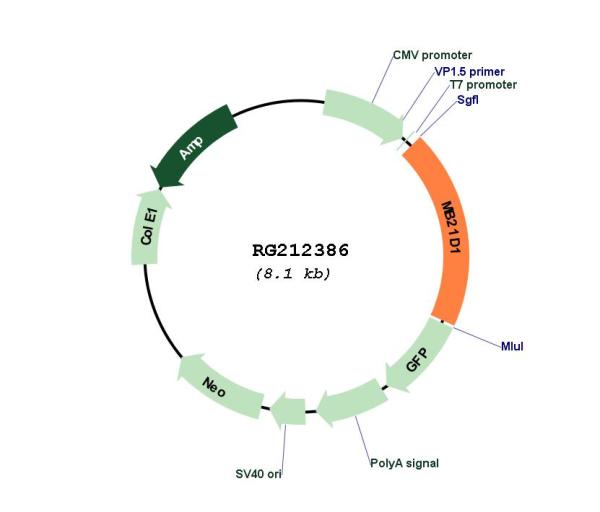C6orf150 (MB21D1) (NM_138441) Human Tagged ORF Clone
CAT#: RG212386
- TrueORF®
MB21D1 (tGFP-tagged) - Human Mab-21 domain containing 1 (MB21D1)
ORF Plasmid: DDK
Lentiviral Particles: DDK DDK w/ Puro mGFP mGFP w/ Puro
"NM_138441" in other vectors (6)
Specifications
| Product Data | |
| Type | Human Tagged ORF Clone |
| Tag | TurboGFP |
| Symbol | C6orf150 |
| Synonyms | C6orf150; h-cGAS; MB21D1 |
| Vector | pCMV6-AC-GFP |
| E. coli Selection | Ampicillin (100 ug/mL) |
| Mammalian Cell Selection | Neomycin |
| Restriction Sites |
SgfI-MluI
Cloning Scheme for this gene
Plasmid Map

|
| ACCN | NM_138441 |
| ORF Size | 1566 bp |
| OTI Disclaimer | The molecular sequence of this clone aligns with the gene accession number as a point of reference only. However, individual transcript sequences of the same gene can differ through naturally occurring variations (e.g. polymorphisms), each with its own valid existence. This clone is substantially in agreement with the reference, but a complete review of all prevailing variants is recommended prior to use. More info |
| OTI Annotation | This clone was engineered to express the complete ORF with an expression tag. Expression varies depending on the nature of the gene. |
| Product Components | The ORF clone is ion-exchange column purified and shipped in a 2D barcoded Matrix tube containing 10ug of transfection-ready, dried plasmid DNA (reconstitute with 100 ul of water). |
| Reconstitution | 1. Centrifuge at 5,000xg for 5min. 2. Carefully open the tube and add 100ul of sterile water to dissolve the DNA. 3. Close the tube and incubate for 10 minutes at room temperature. 4. Briefly vortex the tube and then do a quick spin (less than 5000xg) to concentrate the liquid at the bottom. 5. Store the suspended plasmid at -20°C. The DNA is stable for at least one year from date of shipping when stored at -20°C. |
| Reference Data | |
| RefSeq | NM_138441.1, NP_612450.1 |
| RefSeq Size | 1888 bp |
| RefSeq ORF | 1569 bp |
| Locus ID | 115004 |
| UniProt ID | Q8N884 |
| Cytogenetics | 6q13 |
| Gene Summary | Nucleotidyltransferase that catalyzes the formation of cyclic GMP-AMP (cGAMP) from ATP and GTP and plays a key role in innate immunity (PubMed:23258413, PubMed:23707061, PubMed:23722159, PubMed:24077100, PubMed:25131990, PubMed:29976794, PubMed:30799039). Catalysis involves both the formation of a 2',5' phosphodiester linkage at the GpA step and the formation of a 3',5' phosphodiester linkage at the ApG step, producing c[G(2',5')pA(3',5')p] (PubMed:28363908, PubMed:28214358). Acts as a key cytosolic DNA sensor, the presence of double-stranded DNA (dsDNA) in the cytoplasm being a danger signal that triggers the immune responses (PubMed:28363908). Binds cytosolic DNA directly, leading to activation and synthesis of cGAMP, a second messenger that binds to and activates TMEM173/STING, thereby triggering type-I interferon production (PubMed:28363908, PubMed:28314590). Preferentially recognizes and binds curved long DNAs (PubMed:30007416). In contrast to other mammals, human CGAS displays species-specific mechanisms of DNA recognition and produces less cyclic GMP-AMP (cGAMP), allowing a more fine-tuned response to pathogens (PubMed:30007416). Has antiviral activity by sensing the presence of dsDNA from DNA viruses in the cytoplasm (PubMed:28363908). Also acts as an innate immune sensor of infection by retroviruses, such as HIV-1, by detecting the presence of reverse-transcribed DNA in the cytosol (PubMed:23929945). Detection of retroviral reverse-transcribed DNA in the cytosol may be indirect and be mediated via interaction with PQBP1, which directly binds reverse-transcribed retroviral DNA (PubMed:26046437). Also detects the presence of DNA from bacteria, such as M.tuberculosis (PubMed:26048138). cGAMP can be transferred from producing cells to neighboring cells through gap junctions, leading to promote TMEM173/STING activation and convey immune response to connecting cells (PubMed:24077100). cGAMP can also be transferred between cells by virtue of packaging within viral particles contributing to IFN-induction in newly infected cells in a cGAS-independent but TMEM173/STING-dependent manner (PubMed:26229115). In addition to antiviral activity, also involved in the response to cellular stresses, such as senescence, DNA damage or genome instability (PubMed:28738408, PubMed:28759889). Acts as a regulator of cellular senescence by binding to cytosolic chromatin fragments that are present in senescent cells, leading to trigger type-I interferon production via TMEM173/STING and promote cellular senescence (By similarity). Also involved in the inflammatory response to genome instability and double-stranded DNA breaks: acts by localizing to micronuclei arising from genome instability (PubMed:28738408, PubMed:28759889). Micronuclei, which as frequently found in cancer cells, consist of chromatin surrounded by its own nuclear membrane: following breakdown of the micronuclear envelope, a process associated with chromothripsis, CGAS binds self-DNA exposed to the cytosol, leading to cGAMP synthesis and subsequent activation of TMEM173/STING and type-I interferon production (PubMed:28738408, PubMed:28759889). Acts as a suppressor of DNA repair in response to DNA damage: translocates to the nucleus following dephosphorylation at Tyr-215 and inhibits homologous recombination repair by interacting with PARP1, the CGAS-PARP1 interaction leading to impede the formation of the PARP1-TIMELESS complex (PubMed:30356214).[UniProtKB/Swiss-Prot Function] |
Documents
| Product Manuals |
| FAQs |
| SDS |
Resources
Other Versions
| SKU | Description | Size | Price |
|---|---|---|---|
| RC212386 | MB21D1 (Myc-DDK-tagged)-Human Mab-21 domain containing 1 (MB21D1) |
USD 729.00 |
|
| RC212386L1 | Lenti ORF clone of Human Mab-21 domain containing 1 (MB21D1), Myc-DDK-tagged |
USD 1,029.00 |
|
| RC212386L2 | Lenti ORF clone of Human Mab-21 domain containing 1 (MB21D1), mGFP tagged |
USD 1,029.00 |
|
| RC212386L3 | Lenti ORF clone of Human Mab-21 domain containing 1 (MB21D1), Myc-DDK-tagged |
USD 1,029.00 |
|
| RC212386L4 | Lenti ORF clone of Human Mab-21 domain containing 1 (MB21D1), mGFP tagged |
USD 1,029.00 |
|
| SC313843 | MB21D1 (untagged)-Human Mab-21 domain containing 1 (MB21D1) |
USD 730.00 |
{0} Product Review(s)
Be the first one to submit a review






























































































































































































































































 Germany
Germany
 Japan
Japan
 United Kingdom
United Kingdom
 China
China

